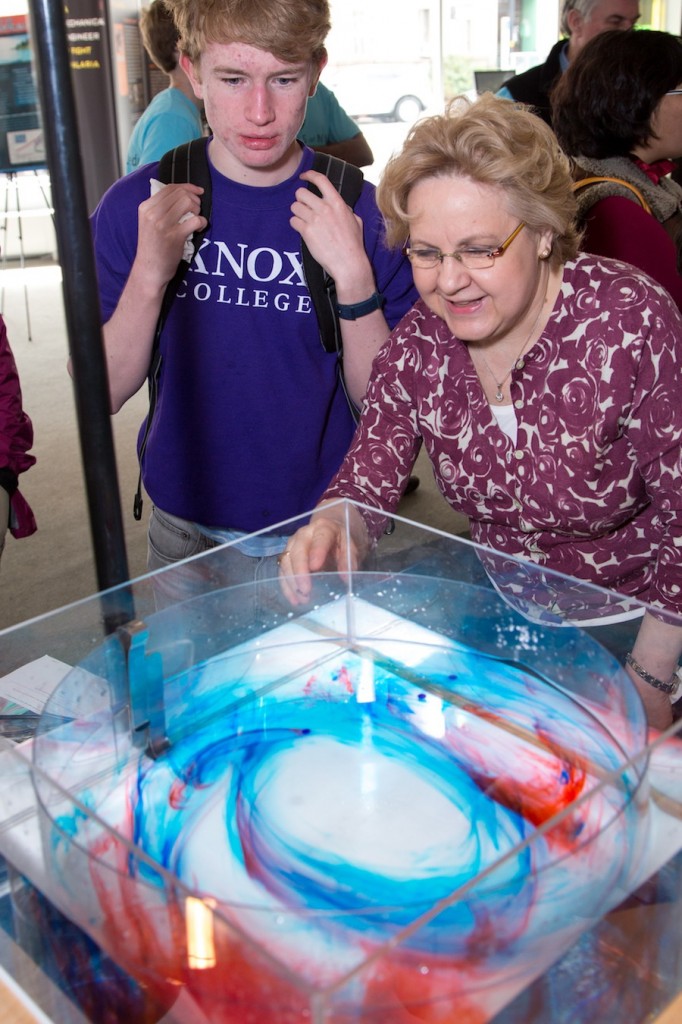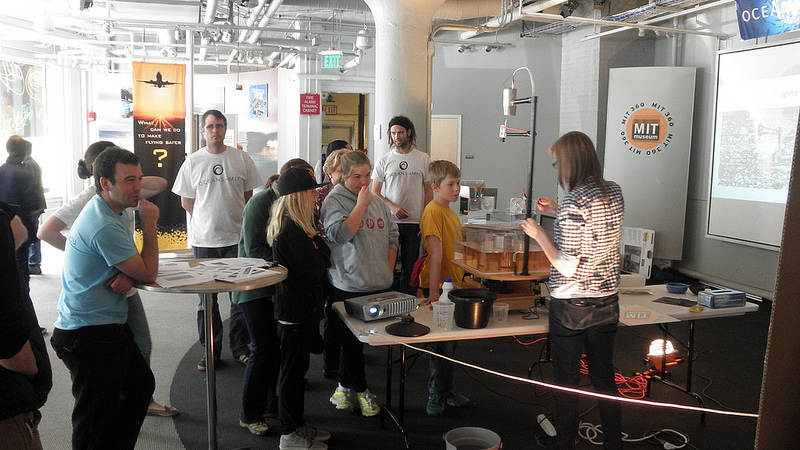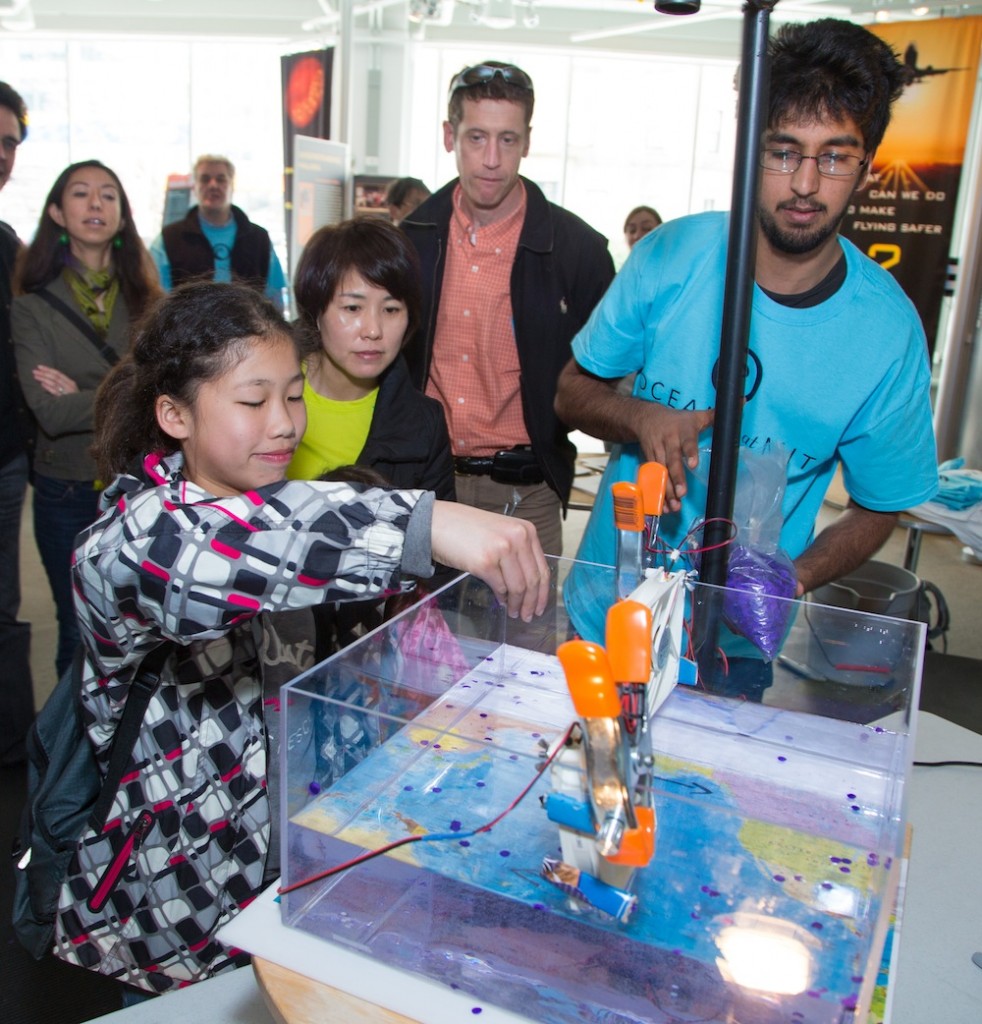Featured Stories, MIT, WHOI | April 30, 2013
Oceans at MIT Makes a Splash at the Cambridge Science Festival
By Genevieve Wanucha
Earlier this month, Oceans at MIT held its largest outreach effort yet at the MIT Museum during the 2013 Cambridge Science Festival. Our exhibit centered around live demonstrations of physical ocean and atmospheric phenomena using rotating tanks of water, dye, and buckets of ice.

The experiments were all performed with Weather in a Tank materials, which are a signature feature of oceanography education in MIT’s Department of Earth, Atmospheric and Planetary Sciences (EAPS). Lodovica Illari, an EAPS senior lecturer, and John Marshall, professor of atmospheric and oceanic sciences designed these tools to enhance the undergraduate weather and climate curriculum, and it’s now been adopted by dozens of schools.
The audience’s favorite Weather in a Tank experience was our demonstration of atmospheric weather systems. To create a cold pole, we placed a bucket of ice in the center of the tank. The ice creates a temperature imbalance inside the cylindrical tank — colder near the bucket (the pole), warmer near the edges (the equator). As the turntable rotates, its motion causes small currents, or eddies, inside the water, which are very close analogues of classic weather patterns. Casey Hilgenbrink, an undergraduate student in MIT’s Program in Atmospheres, Oceans, and Climate, added a few drops of food coloring to make the movements visible, explaining the physics as the dye folded into beautiful swirls.

Another tank experiment revealed the physics behind the formation of the so-called Great Pacific Garbage Patch. We positioned two fans above the rotating tank to simulate the air currents that drive circulation of the North Pacific gyre. The audience dropped little pieces of paper into the whirling water and watched as the particles were slowly pulled toward the center, just as the real ocean gyre accumulates the plastic pollution that falls off the coasts of Japan and California.
Faculty, students, and research staff from EAPS answered many questions from an audience of all ages, including many children with dreams to study marine science. At our table, people could pick up copies of our feature stories and T-Shirts emblazoned with our logo. Writer Genevieve Wanucha and EAPS postdocs and graduate students talked about the ocean research underway at MIT and WHOI and encouraged everyone to stay up to date with Oceans at MIT on Facebook and our Twitter feed at MIT_Oceans.

Woods Hole Oceanographic Institution joined Oceans at MIT in bringing ocean science to the Cambridge Science Festival. “Is the Ocean Becoming More Acidic?” also drew a crowd at the MIT Museum, as WHOI chemists presented their research into how ocean acidification can affect many marine organisms, especially those that build their shells and skeletons from calcium carbonate, such as corals, oysters, clams, mussels, snails, and phytoplankton and zooplankton, which form the base of the marine food web. Alongside chemistry demonstrations, WHOI researchers introduced the audience to the tools they use to study coral skeletons and, best of all, to baby coral organisms growing inside a tank.
Down the street at the Field House at Cambridge Public Library, WHOI’s Broader Impacts Group (BIG) manned their booth “Make the Invisible Visible: The Secret, Bizarre, and Amazing World of Plankton.” There, BIG members gave a live microscope demonstration of the tiny microorganisms, shared amazing video footage, and held an activity to build Super Plankton refrigerator magnets. And last but not least, Synergy, a WHOI-based experiment in art/science communication, presented the art exhibit “Ocean Stories: A Synergy of Art and Science” at the Boston Museum of Science. The colorful show features the work of eight Boston and Cape Cod professional artists who were invited to collaborate with ocean scientists from MIT and the Woods Hole Oceanographic Institution to foster public engagement with ocean science. The ocean-themed events of the Cambridge Science Festival have ended, but you are welcome to visit the Synergy exhibit until June 2.





